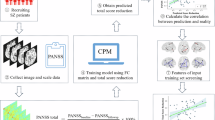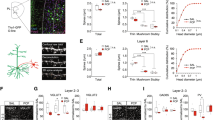Abstract
ΔFosB, a FosB gene product, is induced in the prefrontal cortex (PFC) by repeated exposure to several stimuli including antipsychotic drugs such as haloperidol. However, the functional consequences of increased ΔFosB expression following antipsychotic treatment have not been explored. Here, we assessed whether ΔFosB induction by haloperidol mediates the positive or negative consequences or clinical-related actions of antipsychotic treatment. We show that individuals with schizophrenia who were medicated with antipsychotic drugs at their time of death display increased ΔFosB levels in the PFC, an effect that is replicated in rats treated chronically with haloperidol. In contrast, individuals with schizophrenia who were medication-free did not exhibit this effect. Viral-mediated overexpression of ΔFosB in the PFC of rodents induced cognitive deficits as measured by inhibitory avoidance, increased startle responses in prepulse inhibition tasks, and increased MK-801-induced anxiety-like behaviors. Together, these results suggest that ΔFosB induction in the PFC by antipsychotic treatment contributes to the deleterious effects of these drugs and not to their therapeutic actions.
Similar content being viewed by others
Log in or create a free account to read this content
Gain free access to this article, as well as selected content from this journal and more on nature.com
or
References
Ang E, Chen J, Zagouras P, Magna H, Holland J, Schaeffer E et al (2001). Induction of nuclear factor-κB in nucleus accumbens by chronic cocaine administration. J Neurochem 79: 221–224.
Arguello AA, Ye X, Bozdagi O, Pollonini G, Tronel S, Bambah-Mukku D et al (2013). CCAAT enhancer binding protein Δ Plays an essential role in memory consolidation and reconsolidation. J Neurosci 33: 3646–3658.
Arguello PA, Gogos JA (2006). Modeling madness in mice: one piece at a time. Neuron 52: 179–196.
Atkins JB, Chlan-Fourney J, Nye HE, Hiroi N, Carlezon WA, Nestler EJ (1999). Region-specific induction of ΔFosB by repeated administration of typical versus atypical antipsychotic drugs. Synapse 33: 118–128.
Beerpoot LJ, Lipska BK, Weinberger DR (1996). Neurobiology of treatment-resistant schizophrenia: new insights and new models. Eu Neuropsychopharmacol 6 (Suppl 2): S27–S34.
Bowers ME, Choi DC, Ressler KJ (2012). Neuropeptide regulation of fear and anxiety: Implications of cholecystokinin, endogenous opioids, and neuropeptide Y. Physiol Behavior 107: 699–710.
Cantor-Graae E (2007). The contribution of social factors to the development of schizophrenia: a review of recent findings. Can J Psychiatry 52: 277–286.
Christoffel DJ, Golden SA, Heshmati M, Graham A, Birnbaum S, Neve RL et al (2012). Effects of inhibitor of [kappa]B kinase activity in the nucleus accumbens on emotional behavior. Neuropsychopharmacology 37: 2615–2623.
Conley RR, Kelly DL (2001). Management of treatment resistance in schizophrenia. Biol Psychiatry 50: 898–911.
Hill SK, Bishop JR, Palumbo D, Sweeney JA (2009). Effect of second-generation antipsychotics on cognition: current issues and future challenges. Expert Rev Neurother 10: 43–57.
Hiroi N, Graybiel AM (1996). Atypical and typical neuroleptic treatments induce distinct programs of transcription factor expression in the striatum. J Comp Neurol 374: 70–83.
Hyman SE, Nestler EJ (1996). Initiation and adaptation: a paradigm for understanding psychotropic drug action. Am J Psychiatry 153: 151–162.
Kontkanen O, Törönen P, Lakso M, Wong G, Castrén E (2002). Antipsychotic drug treatment induces differential gene expression in the rat cortex. J Neurochem 83: 1043–1053.
Lader M (1993). Neuroleptic-induced deficit syndrome: old problem, new challenge. J Psychopharmacol (Oxford, England) 7: 392–393.
Lader M (1994). Neuroleptic-induced deficit syndrome. Historical introduction. Acta Psychiatr Scand Suppl 380: 6–7.
Lieberman JA, Stroup TS, McEvoy JP, Swartz MS, Rosenheck RA, Perkins DO et al (2005). Effectiveness of antipsychotic drugs in patients with chronic schizophrenia. N Engl J Med 353: 1209–1223.
Marder SR, Roth B, Sullivan PF, Scolnick EM, Nestler EJ, Geyer MA et al (2011). Advancing drug discovery for schizophrenia. Ann N Y Acad Sci 1236: 30–43.
Maze I, Covington HE, Dietz DM, LaPlant Q, Renthal W, Russo SJ et al (2010). Essential role of the histone methyltransferase g9a in cocaine-induced plasticity. Science 327: 213–216.
Maze I, Feng J, Wilkinson MB, Sun H, Shen L, Nestler EJ (2011). Cocaine dynamically regulates heterochromatin and repetitive element unsilencing in nucleus accumbens. Proc Natl Acad Sci USA 108: 3035–3040.
McClung CA, Nestler EJ (2003). Regulation of gene expression and cocaine reward by CREB and DeltaFosB. Nature Neurosci 6: 1208–1215.
Mead A, Li M, Kapur S (2008). Clozapine and olanzapine exhibit an intrinsic anxiolytic property in two conditioned fear paradigms: contrast with haloperidol and chlordiazepoxide. Pharmacol Biochem Behav 90: 551–562.
Miyamoto S, Miyake N, Jarskog LF, Fleischhacker WW, Lieberman JA (2012). Pharmacological treatment of schizophrenia: a critical review of the pharmacology and clinical effects of current and future therapeutic agents. Mol Psychiatry 17: 1206–1227.
Moreno J, Sealfon S, González-Maeso J (2009). Group II metabotropic glutamate receptors and schizophrenia. Cell Mol Life Sci 66: 3777–3785.
Nestler EJ (2008). Transcriptional mechanisms of addiction: role of deltaFosB. Philos Trans R Soc London B Biol Sci 363: 3245–3255.
Nestler EJ, Hyman SE (2010). Animal models of neuropsychiatric disorders. Nature Neurosci 13: 1161–1169.
Nestler EJ, Kelz MB, Chen JS (1999). ΔFosB: A molecular mediator of long-term neural and behavioral plasticity. Brain Res 835: 10–17.
O’Donnell P (2012). Cortical interneurons, immune factors and oxidative stress as early targets for schizophrenia. Eur J Neurosci 35: 1866–1870.
Park CH, Park TW, Yang JC, Lee KH, Huang GB, Tong Z et al (2012). No negative symptoms in healthy volunteers after single doses of amisulpride, aripiprazole, and haloperidol: a double-blind placebo-controlled trial. Int Clin Psychopharmacol 27: 114–120.
Paxinos G, Franklin K (2003) The Mouse Brain in Stereotaxic Coordinates. Elsevier Publisher: London, UK.
Paxinos G, Watson C (2009) The Rat Brain in Stereotaxic Coordinates. Elsevier Publisher: London, UK.
Perrotti LI, Bolaños CA, Choi K-H, Russo SJ, Edwards S, Ulery PG et al (2005). ΔFosB accumulates in a GABAergic cell population in the posterior tail of the ventral tegmental area after psychostimulant treatment. Eur J Neurosci 21: 2817–2824.
Renthal W, Carle TL, Maze I, Covington HE, Truong H-T, Alibhai I et al (2008). ΔFosB Mediates epigenetic desensitization of the c-fos gene after chronic amphetamine exposure. J Neuroscience 28: 7344–7349.
Savonenko AV, Melnikova T, Laird FM, Stewart K-A, Price DL, Wong PC (2008). Alteration of BACE1-dependent NRG1/ErbB4 signaling and schizophrenia-like phenotypes in BACE1-null mice. Proc Natl Acad Sci USA 105: 5585–5590.
Sawa A, Snyder SH (2002). Schizophrenia: diverse approaches to a complex disease. Science 296: 692–695.
Seedat S, Fritelli V, Oosthuizen P, Emsley RA, Stein DJ (2007). Measuring anxiety in patients with schizophrenia. J Nerv Ment Dis 195: 320–324.
Selten J-P, Cantor-Graae E (2005). Social defeat: risk factor for schizophrenia? Br J Psychiatry 187: 101–102.
Stan AD, Ghose S, Gao XM, Roberts RC, Lewis-Amezcua K, Hatanpaa KJ et al (2006). Human postmortem tissue: what quality markers matter? Brain Res 1123: 1–11.
Sun H, Maze I, Dietz DM, Scobie KN, Kennedy PJ, Damez-Werno D et al (2012). Morphine epigenomically regulates behavior through alterations in histone H3 lysine 9 dimethylation in the nucleus accumbens. J Neurosci 32: 17454–17464.
Suzuki T, Remington G, Mulsant BH, Uchida H, Rajji TK, Graff-Guerrero A et al (2012). Defining treatment-resistant schizophrenia and response to antipsychotics: A review and recommendation. Psychiatry Res 197: 1–6.
Vialou V, Bagot RC, Ferguson D, Feng J, Ku SM, Nestler EJ (2012). Role of deltaFosB in the prefrontal cortex in CCK responses and vulnerability to stress. Neuroscience Meeting Planner New Orleans, LA: Society for Neuroscience 2012.
Acknowledgements
This work was supported by grants from the National Institute of Mental Health (EJN) and National Institute on Alcohol Abuse and Alcoholism (AMG).
Author information
Authors and Affiliations
Corresponding author
Rights and permissions
About this article
Cite this article
Dietz, D., Kennedy, P., Sun, H. et al. ΔFosB Induction in Prefrontal Cortex by Antipsychotic Drugs is Associated with Negative Behavioral Outcomes. Neuropsychopharmacol 39, 538–544 (2014). https://doi.org/10.1038/npp.2013.255
Received:
Revised:
Accepted:
Published:
Issue date:
DOI: https://doi.org/10.1038/npp.2013.255



